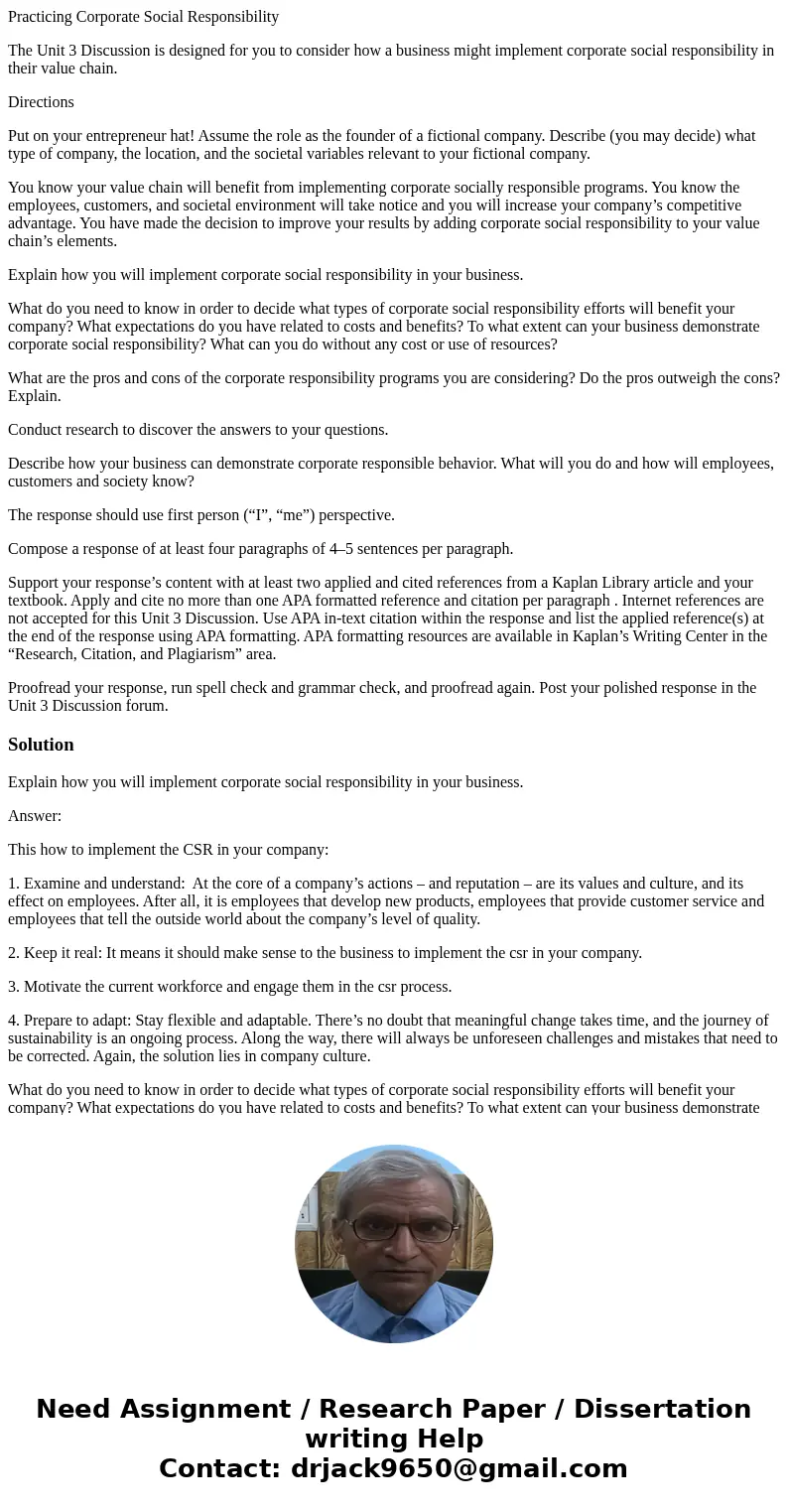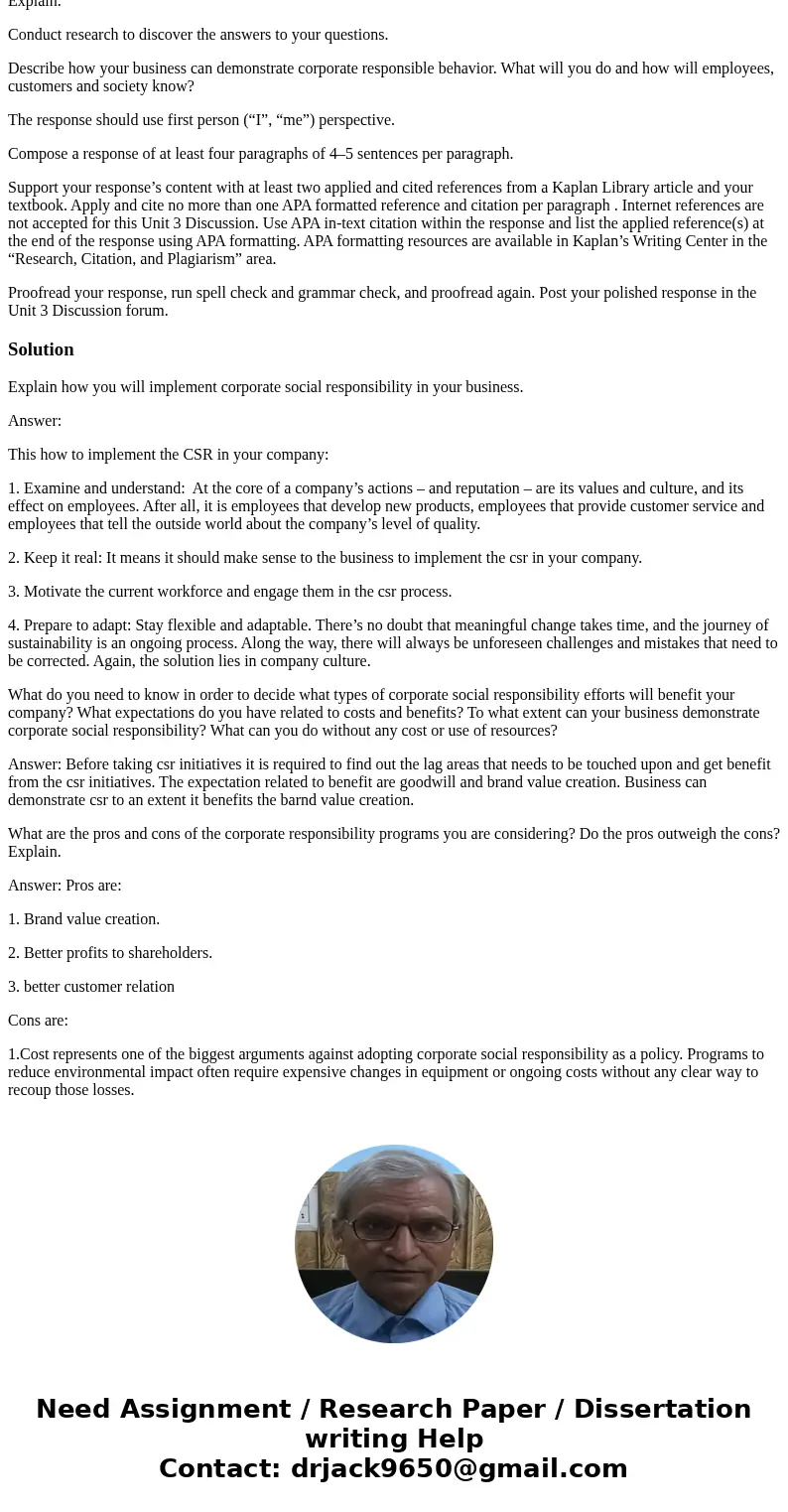Practicing Corporate Social Responsibility The Unit 3 Discus
Practicing Corporate Social Responsibility
The Unit 3 Discussion is designed for you to consider how a business might implement corporate social responsibility in their value chain.
Directions
Put on your entrepreneur hat! Assume the role as the founder of a fictional company. Describe (you may decide) what type of company, the location, and the societal variables relevant to your fictional company.
You know your value chain will benefit from implementing corporate socially responsible programs. You know the employees, customers, and societal environment will take notice and you will increase your company’s competitive advantage. You have made the decision to improve your results by adding corporate social responsibility to your value chain’s elements.
Explain how you will implement corporate social responsibility in your business.
What do you need to know in order to decide what types of corporate social responsibility efforts will benefit your company? What expectations do you have related to costs and benefits? To what extent can your business demonstrate corporate social responsibility? What can you do without any cost or use of resources?
What are the pros and cons of the corporate responsibility programs you are considering? Do the pros outweigh the cons? Explain.
Conduct research to discover the answers to your questions.
Describe how your business can demonstrate corporate responsible behavior. What will you do and how will employees, customers and society know?
The response should use first person (“I”, “me”) perspective.
Compose a response of at least four paragraphs of 4–5 sentences per paragraph.
Support your response’s content with at least two applied and cited references from a Kaplan Library article and your textbook. Apply and cite no more than one APA formatted reference and citation per paragraph . Internet references are not accepted for this Unit 3 Discussion. Use APA in-text citation within the response and list the applied reference(s) at the end of the response using APA formatting. APA formatting resources are available in Kaplan’s Writing Center in the “Research, Citation, and Plagiarism” area.
Proofread your response, run spell check and grammar check, and proofread again. Post your polished response in the Unit 3 Discussion forum.
Solution
Explain how you will implement corporate social responsibility in your business.
Answer:
This how to implement the CSR in your company:
1. Examine and understand: At the core of a company’s actions – and reputation – are its values and culture, and its effect on employees. After all, it is employees that develop new products, employees that provide customer service and employees that tell the outside world about the company’s level of quality.
2. Keep it real: It means it should make sense to the business to implement the csr in your company.
3. Motivate the current workforce and engage them in the csr process.
4. Prepare to adapt: Stay flexible and adaptable. There’s no doubt that meaningful change takes time, and the journey of sustainability is an ongoing process. Along the way, there will always be unforeseen challenges and mistakes that need to be corrected. Again, the solution lies in company culture.
What do you need to know in order to decide what types of corporate social responsibility efforts will benefit your company? What expectations do you have related to costs and benefits? To what extent can your business demonstrate corporate social responsibility? What can you do without any cost or use of resources?
Answer: Before taking csr initiatives it is required to find out the lag areas that needs to be touched upon and get benefit from the csr initiatives. The expectation related to benefit are goodwill and brand value creation. Business can demonstrate csr to an extent it benefits the barnd value creation.
What are the pros and cons of the corporate responsibility programs you are considering? Do the pros outweigh the cons? Explain.
Answer: Pros are:
1. Brand value creation.
2. Better profits to shareholders.
3. better customer relation
Cons are:
1.Cost represents one of the biggest arguments against adopting corporate social responsibility as a policy. Programs to reduce environmental impact often require expensive changes in equipment or ongoing costs without any clear way to recoup those losses.


 Homework Sourse
Homework Sourse